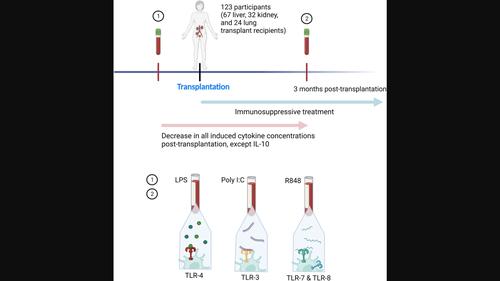求助PDF
{"title":"实体器官移植前后toll样受体配体诱导的细胞因子浓度的差异:一项临床前瞻性观察队列研究","authors":"Dina Leth Møller, Søren Schwartz Sørensen, Michael Perch, Finn Gustafsson, Annemette Hald, Andreas Delhbæk Knudsen, Ranya Abdulovski, Nicoline Stender Arentoft, Jens Lundgren, Allan Rasmussen, Sisse Rye Ostrowski, Susanne Dam Nielsen","doi":"10.1111/sji.13337","DOIUrl":null,"url":null,"abstract":"Reliable methods to assess immune function after solid organ transplantation (SOT) are needed to guide dosing of immunosuppression. We hypothesized that toll-like receptor ligand-induced cytokine concentrations would decrease post-transplantation due to the use of immunosuppressive medication. Furthermore, we hypothesized that induced cytokine concentrations pre-transplantation would be higher in recipients with episodes of acute rejection post-transplantation due to underlying immunological dispositions. We aimed to investigate toll-like receptor ligand-induced cytokine concentrations by TruCulture©, a standardized immunoassay, in SOT recipients before and 3 months after SOT and explored associations with methylprednisolone-treated acute rejections. We conducted a prospective, observational cohort study including 123 participants (67 liver, 32 kidney and 24 lung transplant recipients). Whole blood was stimulated for 22 h with: (A) Lipopolysaccharide (LPS), (B) Resiquimod, (C) Polyinosinic:polycytidylic acid (Poly I:C) and (D) a blank control. Cytokine concentrations (TNF-α, IL-1β, IL-6, IL-8, IL-10, IL-12p40, IL-17A, IFN-α and IFN-γ) were measured by Luminex. 30 participants developed methylprednisolone-treated acute rejection at a median of 9 days (IQR 5–17) post-SOT. We found that all induced cytokine concentrations decreased post-SOT except from LPS-induced and Poly I:C-induced IL-10. The induced cytokine concentration pre-transplantation did not differ in recipients with or without acute rejection. In conclusion, the induced cytokine concentrations decreased for all stimuli post-SOT, except the anti-inflammatory cytokine IL-10. Importantly, recipients developing early acute rejection did not differ in induced cytokine concentrations pre-SOT. Thus, the use of a standardized assay in SOT is feasible in a clinical setting and may provide important information on the immune function post-SOT.","PeriodicalId":21493,"journal":{"name":"Scandinavian Journal of Immunology","volume":"45 5","pages":""},"PeriodicalIF":4.1000,"publicationDate":"2023-11-20","publicationTypes":"Journal Article","fieldsOfStudy":null,"isOpenAccess":false,"openAccessPdf":"","citationCount":"0","resultStr":"{\"title\":\"Differences in toll-like receptor ligand-induced cytokine concentrations before and after solid organ transplantation: A prospective, observational cohort study in a clinical setting\",\"authors\":\"Dina Leth Møller, Søren Schwartz Sørensen, Michael Perch, Finn Gustafsson, Annemette Hald, Andreas Delhbæk Knudsen, Ranya Abdulovski, Nicoline Stender Arentoft, Jens Lundgren, Allan Rasmussen, Sisse Rye Ostrowski, Susanne Dam Nielsen\",\"doi\":\"10.1111/sji.13337\",\"DOIUrl\":null,\"url\":null,\"abstract\":\"Reliable methods to assess immune function after solid organ transplantation (SOT) are needed to guide dosing of immunosuppression. We hypothesized that toll-like receptor ligand-induced cytokine concentrations would decrease post-transplantation due to the use of immunosuppressive medication. Furthermore, we hypothesized that induced cytokine concentrations pre-transplantation would be higher in recipients with episodes of acute rejection post-transplantation due to underlying immunological dispositions. We aimed to investigate toll-like receptor ligand-induced cytokine concentrations by TruCulture©, a standardized immunoassay, in SOT recipients before and 3 months after SOT and explored associations with methylprednisolone-treated acute rejections. We conducted a prospective, observational cohort study including 123 participants (67 liver, 32 kidney and 24 lung transplant recipients). Whole blood was stimulated for 22 h with: (A) Lipopolysaccharide (LPS), (B) Resiquimod, (C) Polyinosinic:polycytidylic acid (Poly I:C) and (D) a blank control. Cytokine concentrations (TNF-α, IL-1β, IL-6, IL-8, IL-10, IL-12p40, IL-17A, IFN-α and IFN-γ) were measured by Luminex. 30 participants developed methylprednisolone-treated acute rejection at a median of 9 days (IQR 5–17) post-SOT. We found that all induced cytokine concentrations decreased post-SOT except from LPS-induced and Poly I:C-induced IL-10. The induced cytokine concentration pre-transplantation did not differ in recipients with or without acute rejection. In conclusion, the induced cytokine concentrations decreased for all stimuli post-SOT, except the anti-inflammatory cytokine IL-10. Importantly, recipients developing early acute rejection did not differ in induced cytokine concentrations pre-SOT. Thus, the use of a standardized assay in SOT is feasible in a clinical setting and may provide important information on the immune function post-SOT.\",\"PeriodicalId\":21493,\"journal\":{\"name\":\"Scandinavian Journal of Immunology\",\"volume\":\"45 5\",\"pages\":\"\"},\"PeriodicalIF\":4.1000,\"publicationDate\":\"2023-11-20\",\"publicationTypes\":\"Journal Article\",\"fieldsOfStudy\":null,\"isOpenAccess\":false,\"openAccessPdf\":\"\",\"citationCount\":\"0\",\"resultStr\":null,\"platform\":\"Semanticscholar\",\"paperid\":null,\"PeriodicalName\":\"Scandinavian Journal of Immunology\",\"FirstCategoryId\":\"3\",\"ListUrlMain\":\"https://doi.org/10.1111/sji.13337\",\"RegionNum\":4,\"RegionCategory\":\"医学\",\"ArticlePicture\":[],\"TitleCN\":null,\"AbstractTextCN\":null,\"PMCID\":null,\"EPubDate\":\"\",\"PubModel\":\"\",\"JCR\":\"Q2\",\"JCRName\":\"IMMUNOLOGY\",\"Score\":null,\"Total\":0}","platform":"Semanticscholar","paperid":null,"PeriodicalName":"Scandinavian Journal of Immunology","FirstCategoryId":"3","ListUrlMain":"https://doi.org/10.1111/sji.13337","RegionNum":4,"RegionCategory":"医学","ArticlePicture":[],"TitleCN":null,"AbstractTextCN":null,"PMCID":null,"EPubDate":"","PubModel":"","JCR":"Q2","JCRName":"IMMUNOLOGY","Score":null,"Total":0}
引用次数: 0
引用
批量引用
Differences in toll-like receptor ligand-induced cytokine concentrations before and after solid organ transplantation: A prospective, observational cohort study in a clinical setting
Reliable methods to assess immune function after solid organ transplantation (SOT) are needed to guide dosing of immunosuppression. We hypothesized that toll-like receptor ligand-induced cytokine concentrations would decrease post-transplantation due to the use of immunosuppressive medication. Furthermore, we hypothesized that induced cytokine concentrations pre-transplantation would be higher in recipients with episodes of acute rejection post-transplantation due to underlying immunological dispositions. We aimed to investigate toll-like receptor ligand-induced cytokine concentrations by TruCulture©, a standardized immunoassay, in SOT recipients before and 3 months after SOT and explored associations with methylprednisolone-treated acute rejections. We conducted a prospective, observational cohort study including 123 participants (67 liver, 32 kidney and 24 lung transplant recipients). Whole blood was stimulated for 22 h with: (A) Lipopolysaccharide (LPS), (B) Resiquimod, (C) Polyinosinic:polycytidylic acid (Poly I:C) and (D) a blank control. Cytokine concentrations (TNF-α, IL-1β, IL-6, IL-8, IL-10, IL-12p40, IL-17A, IFN-α and IFN-γ) were measured by Luminex. 30 participants developed methylprednisolone-treated acute rejection at a median of 9 days (IQR 5–17) post-SOT. We found that all induced cytokine concentrations decreased post-SOT except from LPS-induced and Poly I:C-induced IL-10. The induced cytokine concentration pre-transplantation did not differ in recipients with or without acute rejection. In conclusion, the induced cytokine concentrations decreased for all stimuli post-SOT, except the anti-inflammatory cytokine IL-10. Importantly, recipients developing early acute rejection did not differ in induced cytokine concentrations pre-SOT. Thus, the use of a standardized assay in SOT is feasible in a clinical setting and may provide important information on the immune function post-SOT.


